Sustainable Development in the Colombian Post-Conflict—The Impact of Renewable Energies in Coffee-Growing Women
Abstract
1. Introduction
2. Materials and Methods
2.1. Biodigesters: Background on the Specialty Coffees of Tolima Project, 2018
2.1.1. Selection of Beneficiaries, 2018
2.1.2. Characteristics of the Biodigesters and Thermal System, 2018
2.2. Evaluation of the Impacts Associated with the Biodigesters’ Installation, 2022
2.3. Role of Women in the Coffee Sector
3. Results
3.1. Biodigesters: Background on the Specialty Coffees of Tolima Project, 2018
3.1.1. Selection of Beneficiaries, 2018
3.1.2. Operation of the Biodigesters, 2018
3.2. Evaluation of the Impacts Associated with the Biodigesters’ Installation, 2022
4. Discussion
4.1. Biodigesters
4.2. Evaluation of the Impacts Associated with the Biodigesters’ Installation, 2022
Brief Analysis of the Social Context in the Area Studied
5. Conclusions
6. Directions for Further Research
Author Contributions
Funding
Institutional Review Board Statement
Informed Consent Statement
Data Availability Statement
Acknowledgments
Conflicts of Interest
Appendix A. Technical Specifications of the Questionnaire
| Constructs | Operational Definition | Questions | Type of Question | Answer Options |
|---|---|---|---|---|
| 1. Quality of life | The perceived level of well-being derived from each person’s evaluation of objective and subjective elements in different dimensions of her life in relation to the installation and use of the biodigester. | 1.1 Do you consider that your quality of life has improved since the installation of the biodigester? | Closed-ended question | Yes/No |
| 1.1.1 Why? | Open-ended question | |||
| 1.2 Since the installation of the biodigester, have your daily routines changed? | Closed-ended question | Yes/No | ||
| 1.2.1 Please describe the main changes in your routine. | Open-ended question | |||
| 1.3 Do you consider these changes in your routine are positive? | Closed-ended question | Yes/No | ||
| 1.4 Before the installation of the biodigester, how many hours did you spend on average in the kitchen during a day? | Open-ended question | |||
| 1.5 Currently, how many hours a day do you spend in the kitchen? | Open-ended question | |||
| 1.6 Do you consider that the installation of the biodigester benefits your health? | Closed-ended question | Yes/No | ||
| 1.7 Do you consider that the installation of the biodigester benefits your family’s health? | Closed-ended question | Yes/No | ||
| 1.8 Since the installation of the biodigester, have any adjustments been made to the infrastructure or equipment of the farm? | Closed-ended question | Yes/No | ||
| 1.8.1 If yes, which ones? | Open-ended question | |||
| 1.9 Do you consider that the installation of biodigesters in other farms could improve the quality of life of the community? | Closed-ended question | Yes/No | ||
| 2. Role of women in clean energy implementation | Women’s perception of their own role in the family and community in aspects related to the implementation, maintenance and sustainability of biodigesters. | 2.1 Have you participated in the care and maintenance process of the biodigester? | Closed-ended question | Yes/No |
| 2.2 What has been your role in the maintenance of the biodigester? | Open-ended question | |||
| 2.3 What challenges have you faced in maintaining the biodigester? How have you overcome them? | Open-ended question | |||
| 2.4 Do you consider that your role in the maintenance of the biodigester has been important? | Closed-ended question | Yes/No | ||
| 2.4.1 Why? | Open-ended question | |||
| 2.5 With the installation of the biodigester, your tasks at home have become: | Closed-ended question | Easier More complex Do not perceive any change | ||
| 2.6 Do you consider that the biodigester implies a greater workload for you on the farm? | Closed-ended question | Yes/No | ||
| 2.7 Do you consider that your participation in the care of the biodigester strengthens your leadership with your family? | Closed-ended question | Yes/No | ||
| 2.8 Do you consider that your participation in the care of the biodigester strengthens your leadership with your community? | Closed-ended question | Yes/No | ||
| 3. Social appropriation in the family | The process of learning and understanding of the family/community to effectively, habitually and continuously use the biodigester in their daily activities and manage its maintenance based on the acquisition of knowledge and the development of skills. | 3.1 Who is usually responsible for the maintenance activities of the biodigester? | Closed-ended question | Mom _______ Dad _______ Grandpa _______ Grandma _______ Boy _______ Girl _______ Other: ____ |
| 3.2 How do you rate the learning process regarding the maintenance of the biodigester? | Closed-ended question | Easy Intermediate difficulty Hard | ||
| 3.3 What are the current uses of the biogas generated in the biodigester on the farm? | Open-ended question | |||
| 3.4 Have you perceived interest from your children or grandchildren in the care of the biodigester? | Closed-ended question | Yes/No | ||
| 3.5 Have you perceived interest from your neighbors to learn about the installation and maintenance of a biodigester? | Closed-ended question | Yes/No | ||
| 3.6 Have you taught other members of your family how to take care of the biodigester? | Closed-ended question | Yes/No | ||
| 3.7 Have you shared your experience regarding the installation and maintenance of the biodigester with members of your community? | Closed-ended question | Yes/No | ||
| 3.8 Would you like to share your experiences and learnings with your community regarding biodigester installation and maintenance? | Closed-ended question | Yes/No | ||
| 4. Environmental sustainability | Perceived environmental benefits from the installation of the biodigester | 4.1 Before the installation of the biodigester, how many kilograms of firewood did you use in a day for the development of the farm’s activities? | Open-ended question | |
| 4.2 After the installation of the biodigester, on average, how many kilograms of firewood do you use in a day for the development of the farm’s activities? | Open-ended question | |||
| 4.3 From which vegetable species do you usually take firewood? | Open-ended question | |||
| 4.4 Have you stopped buying gas pipettes? | Closed-ended question | Yes/No | ||
| 4.4.1 How many? | Open-ended question |
Appendix B. Results of the Telephone Interview
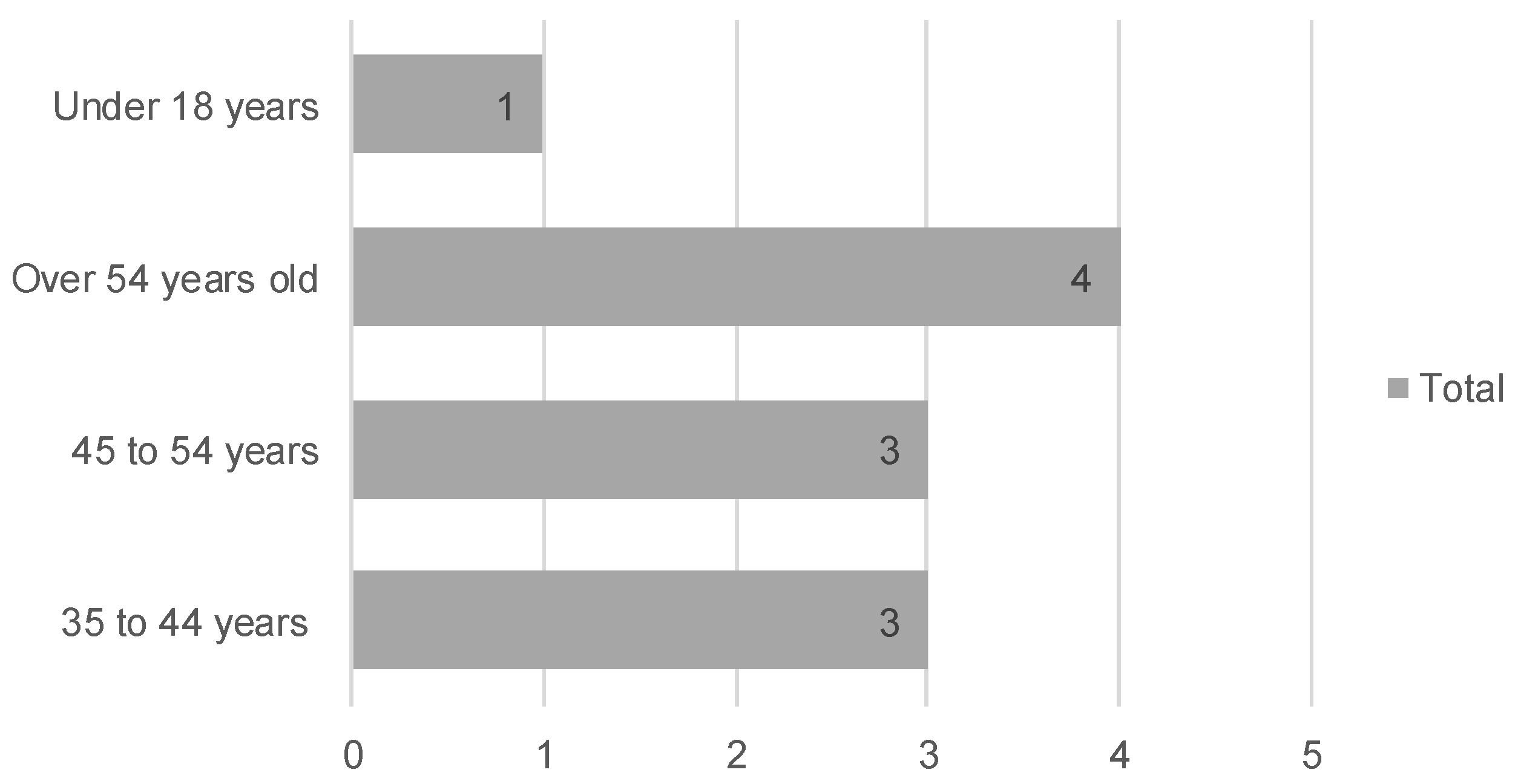
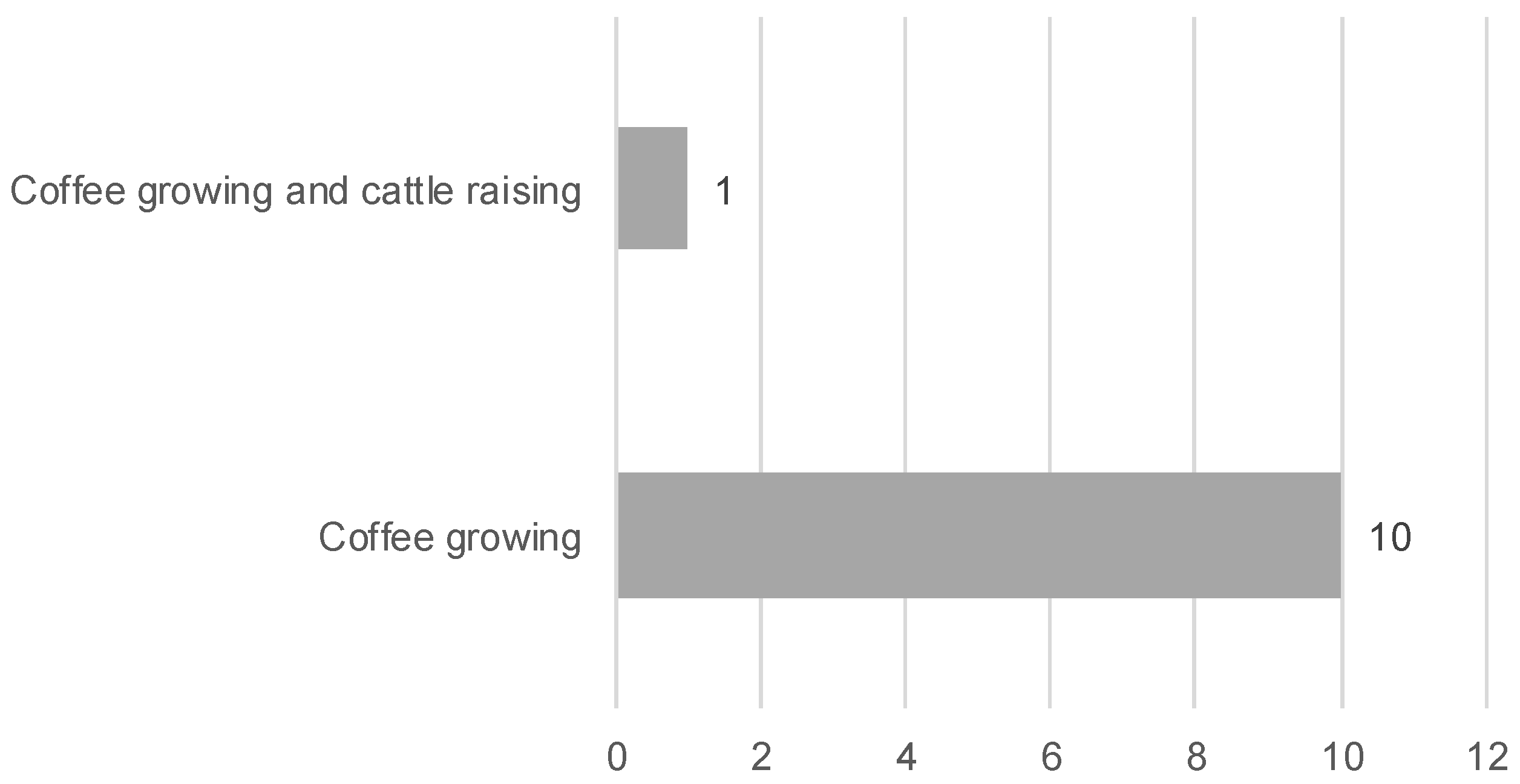
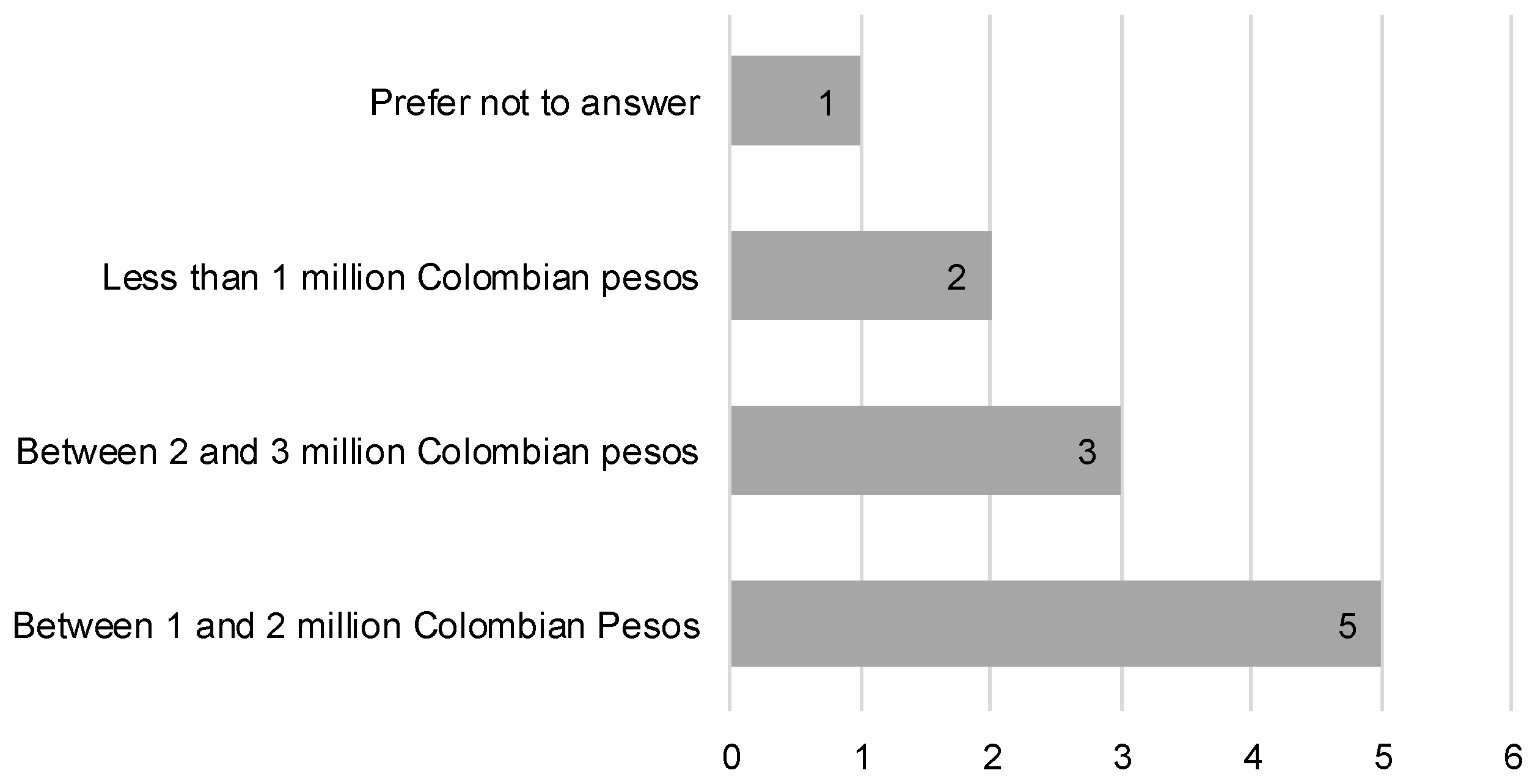
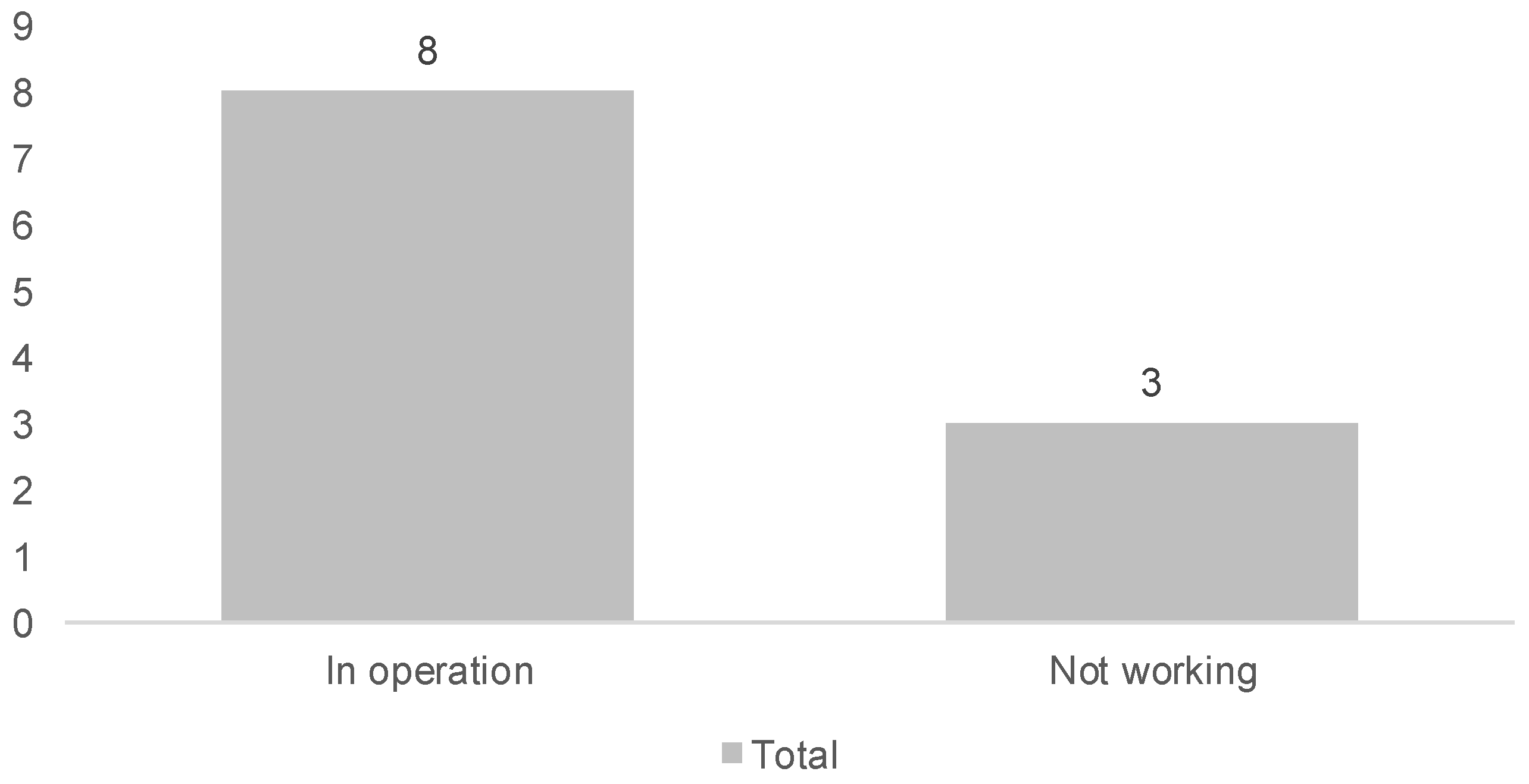
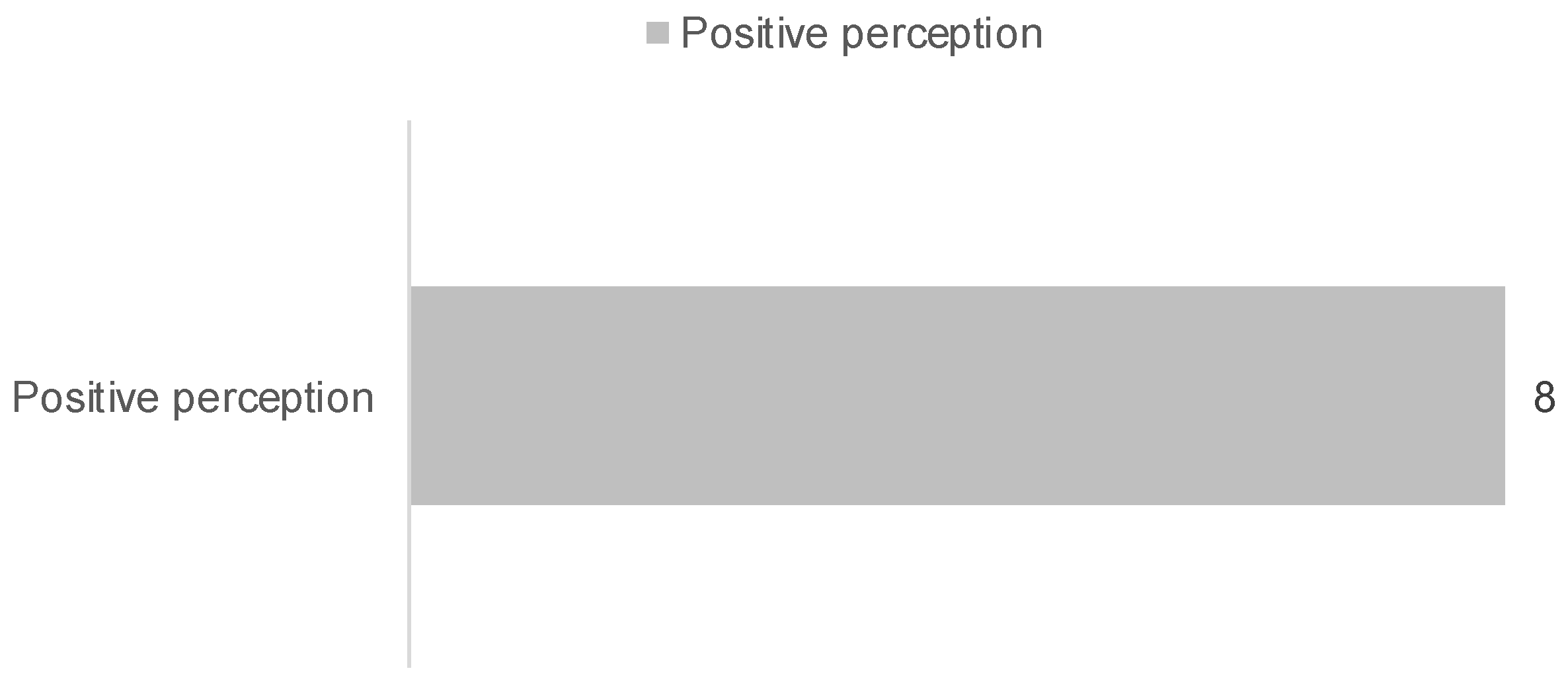
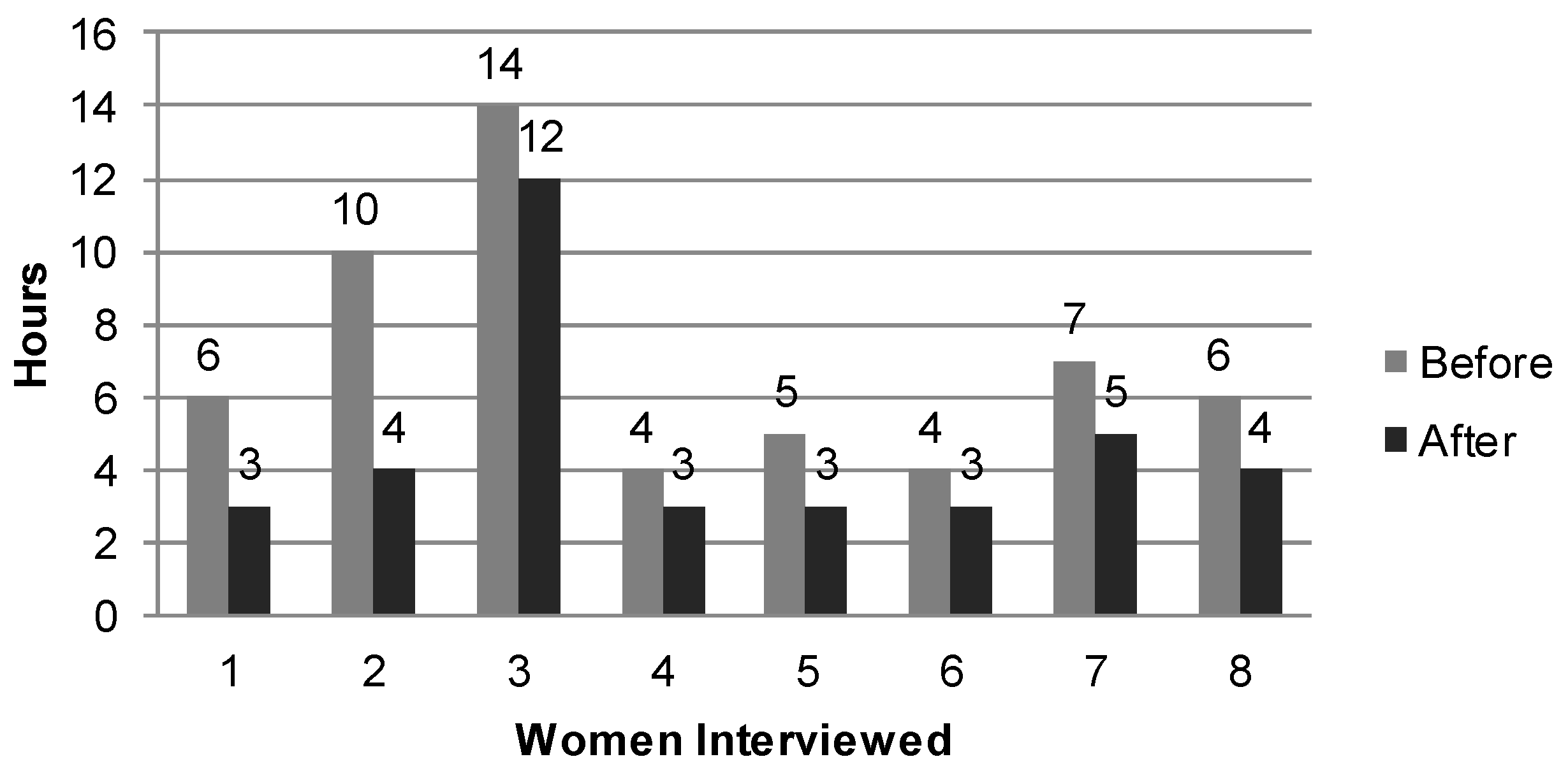
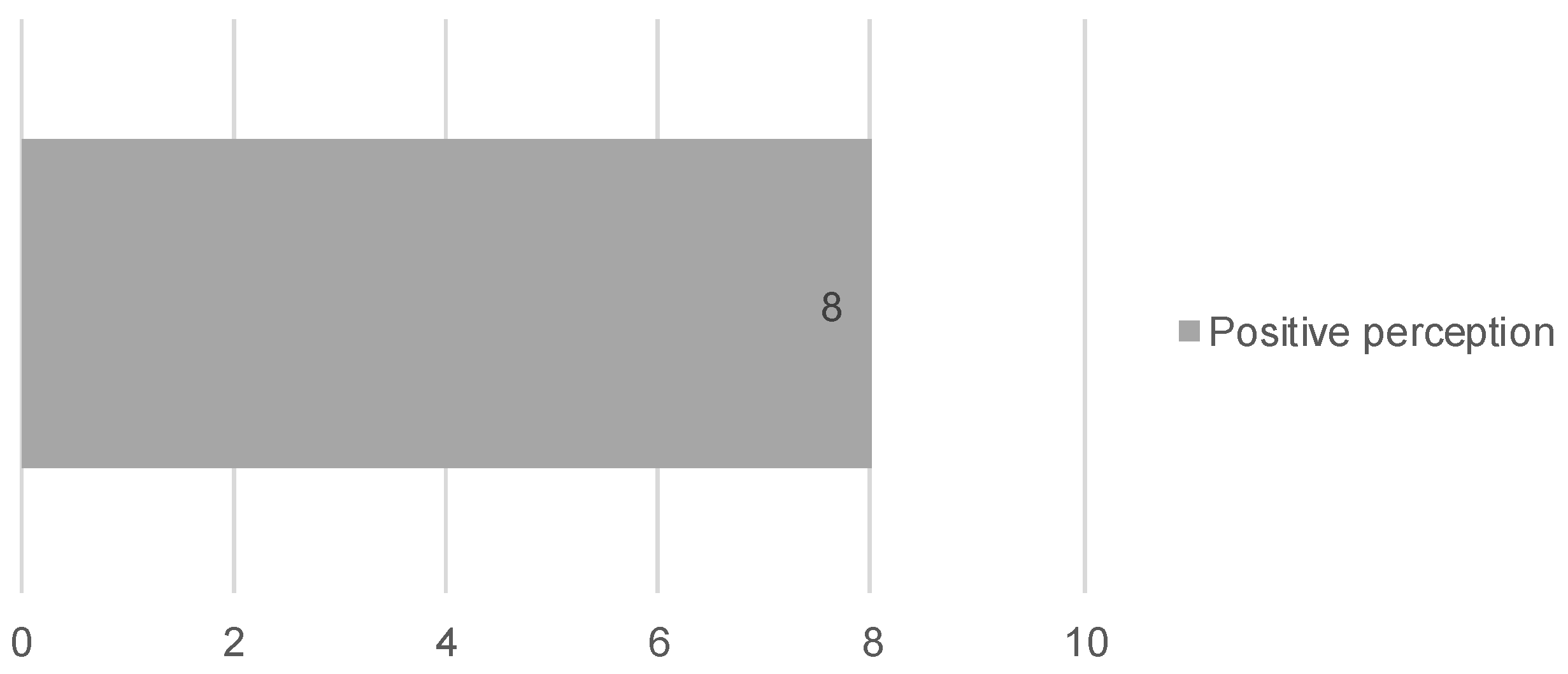
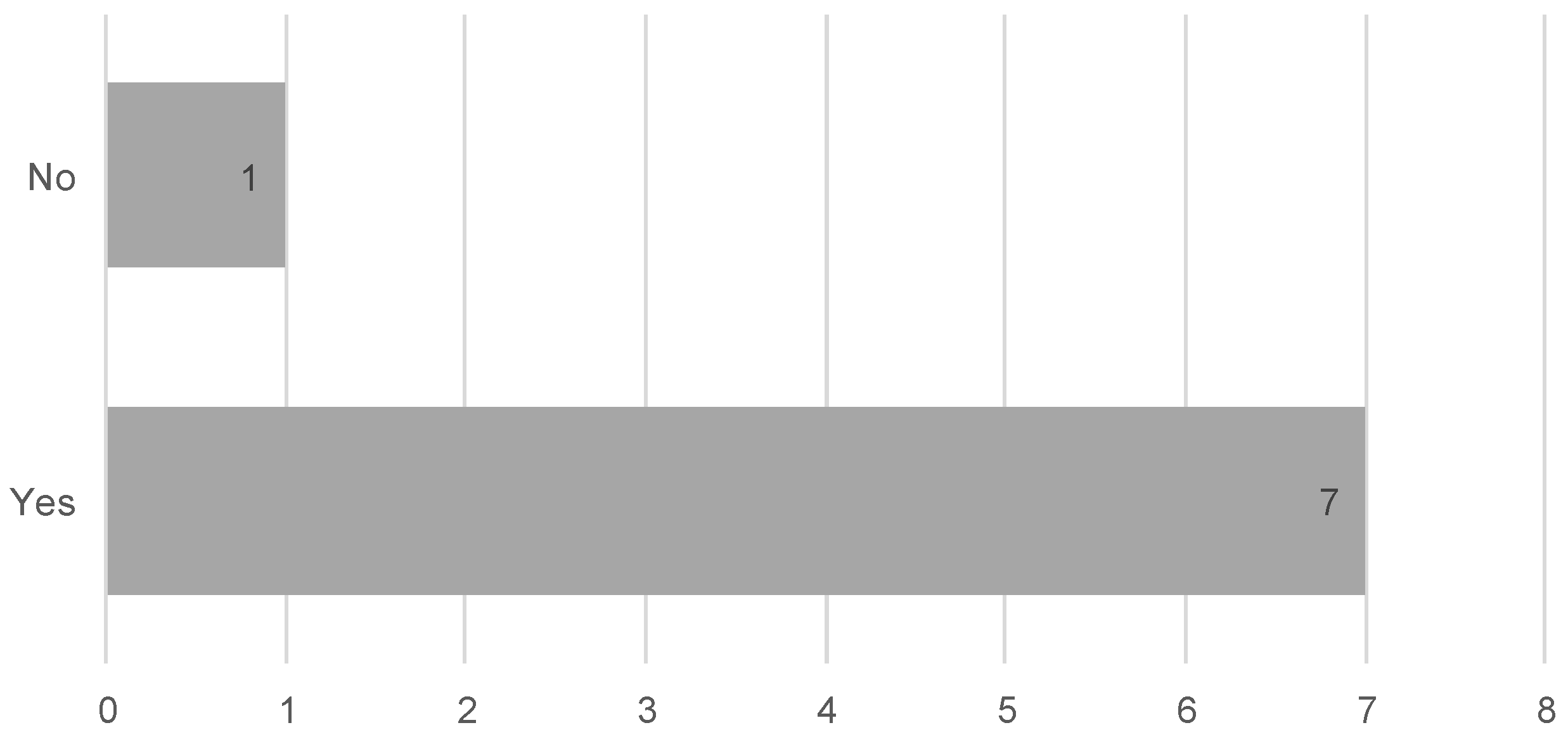
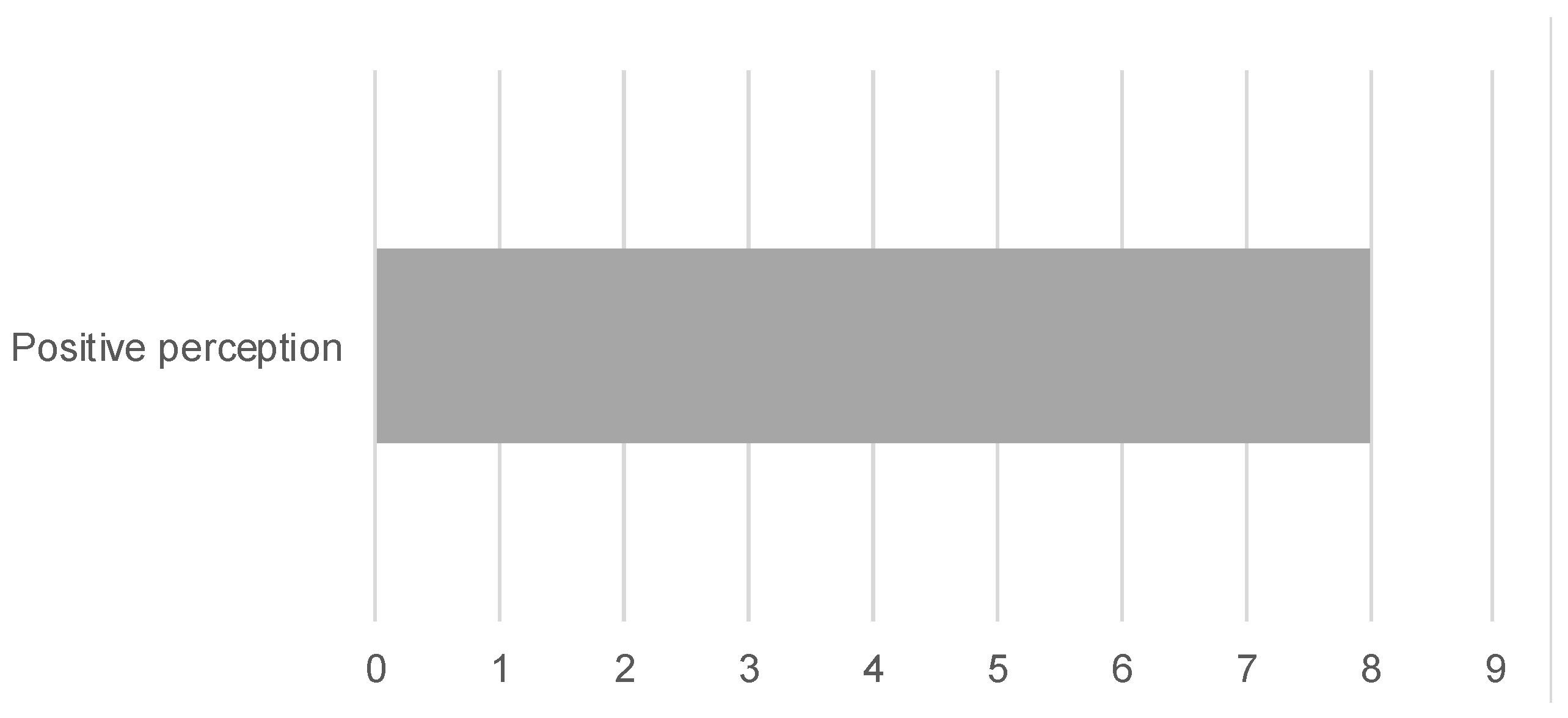
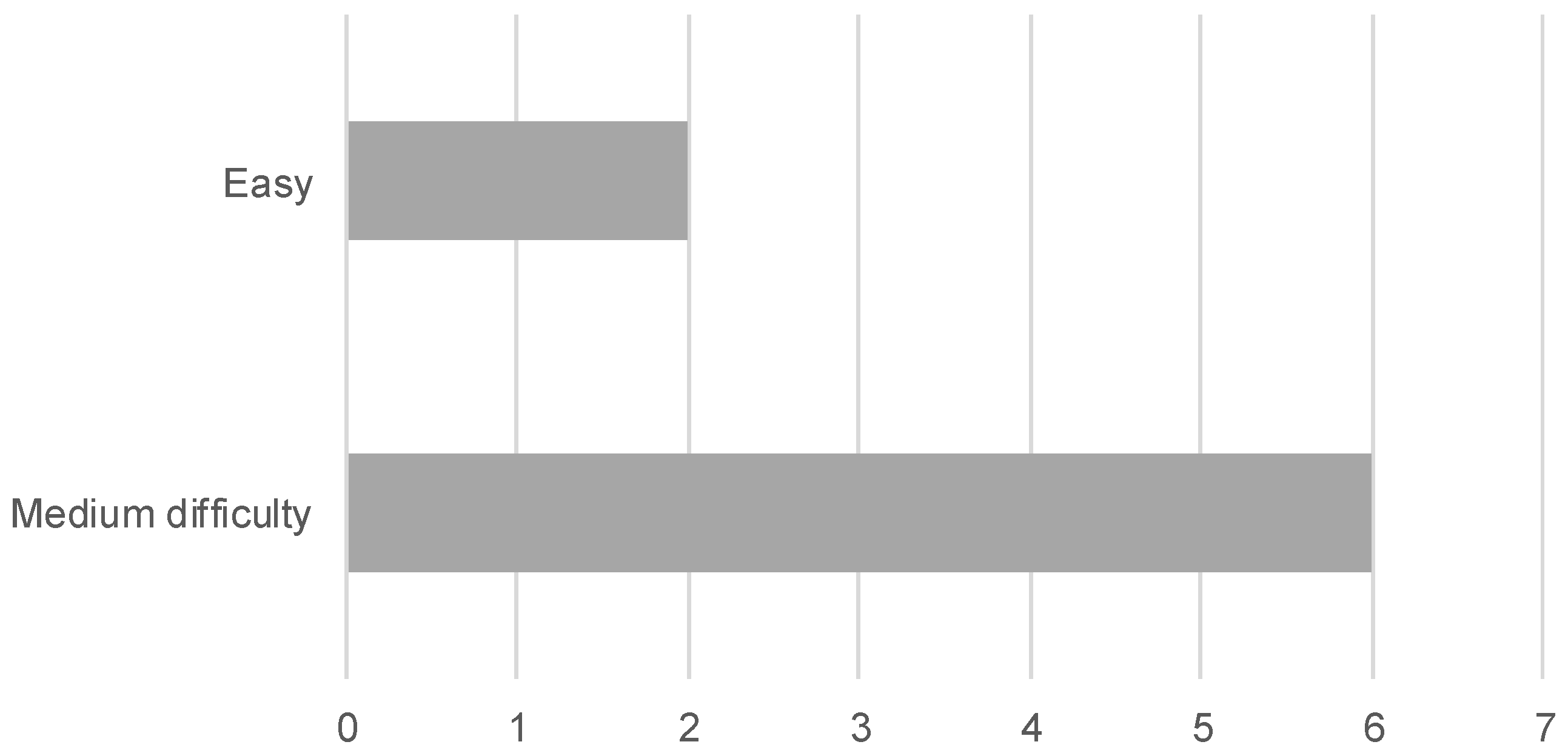
Appendix C. Geographical Ubication of Installed Biodigesters
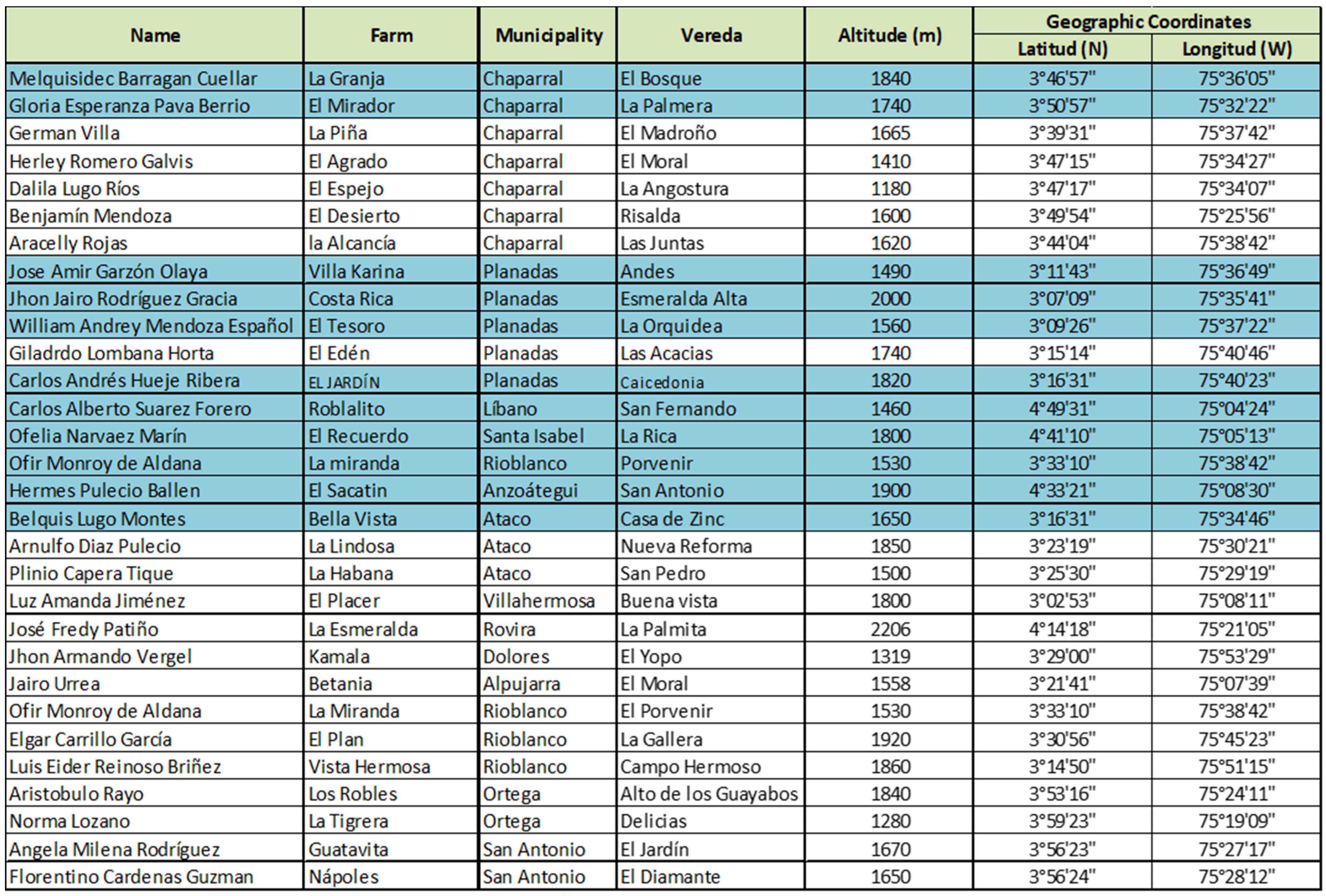
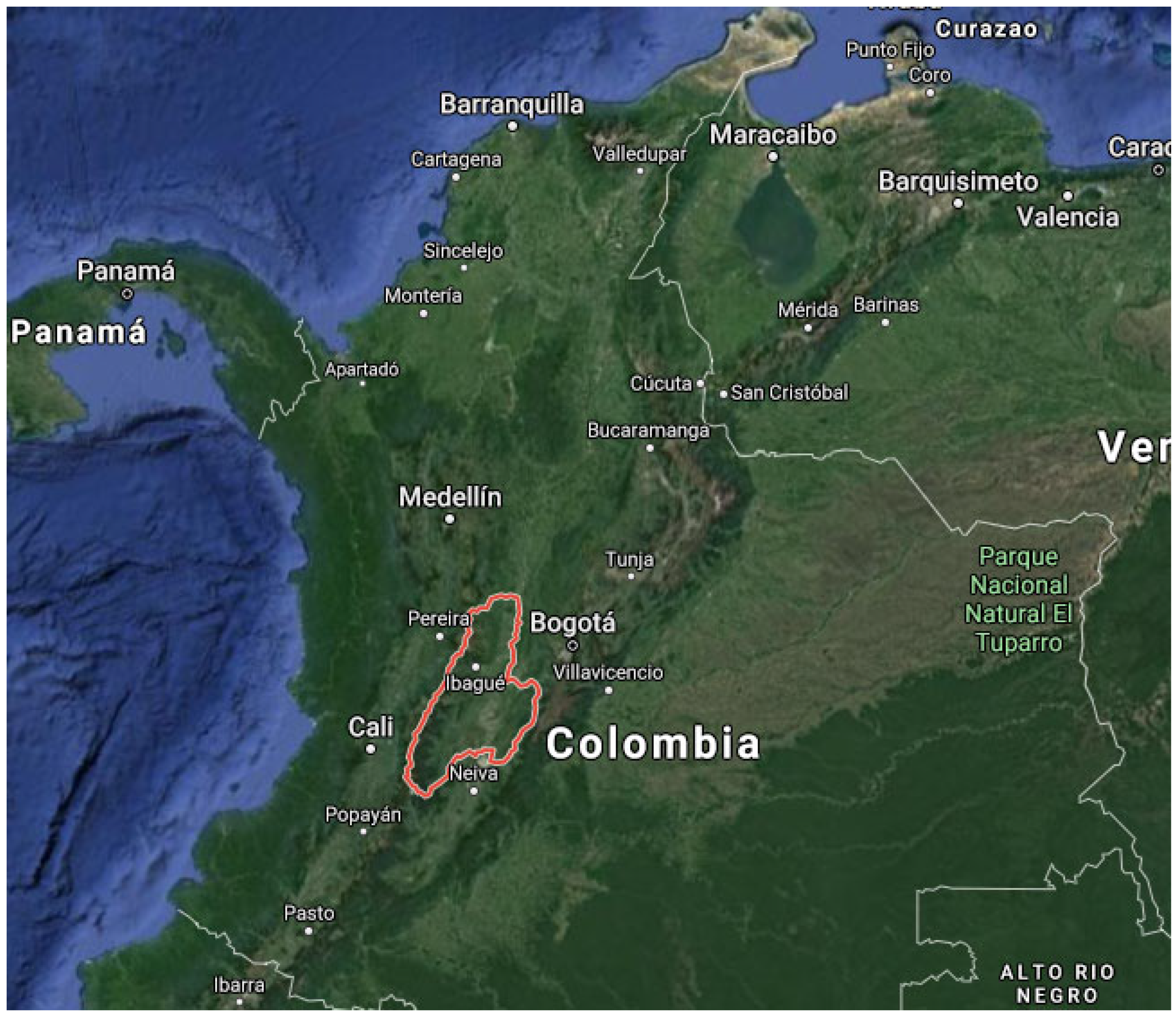
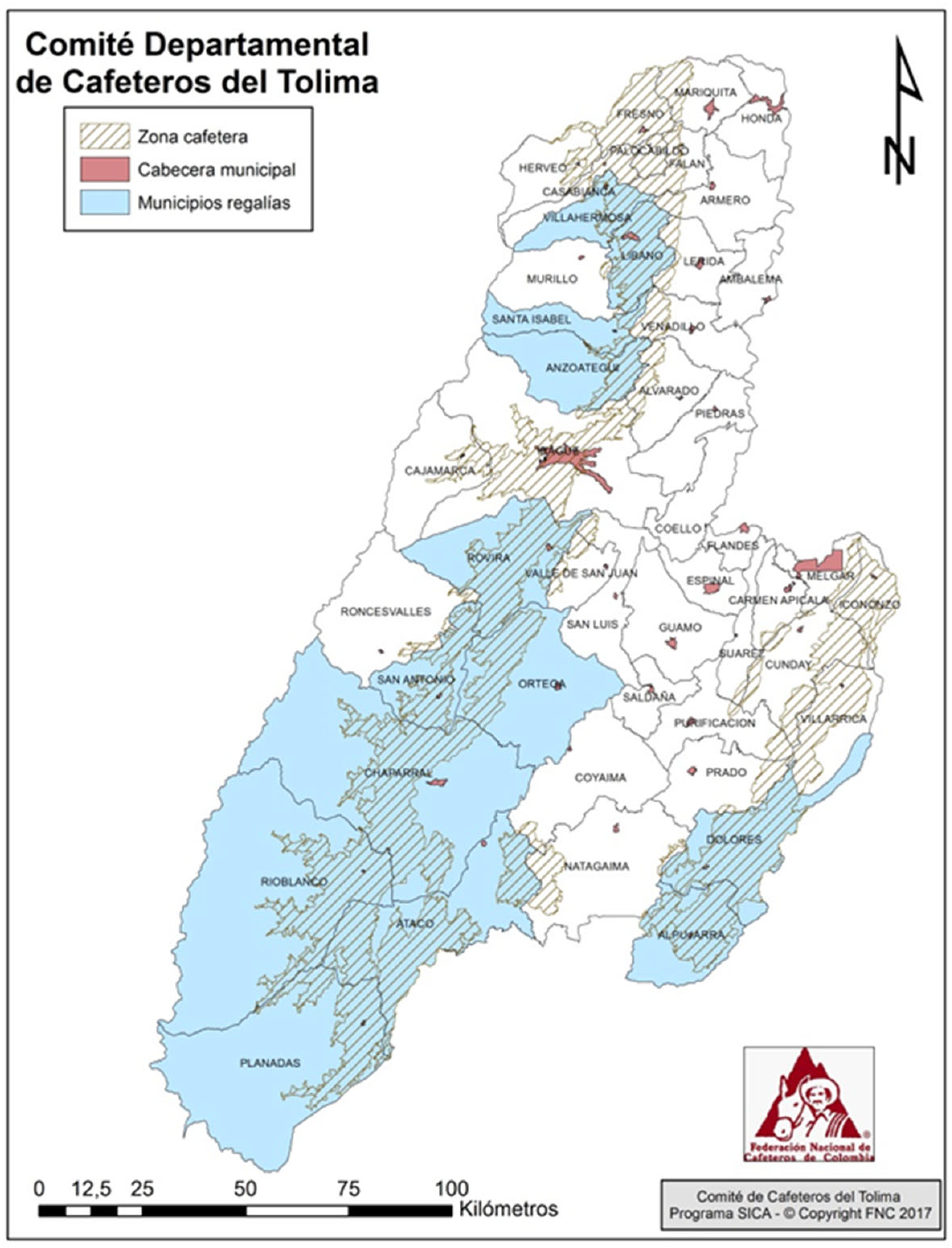
References
- Comité Departamental de Cafeteros del Tolima. Informe Social Tolima Café de Alta Calidad; Comité Departamental de Cafeteros del Tolima: Ibagué, Colombia, 2019. [Google Scholar]
- Federación Nacional de Cafeteros de Colombia. Producción de Café de Colombia Cierra 2021 En 12,6 Millones de Sacos; Federación Nacional de Cafeteros de Colombia: Bogota, Colombia, 2021. [Google Scholar]
- Acosta, L.J. Con Menores Costos y Más Calidad Caficultores de Colombia Buscarán Mantener Rentabilidad en 2020. Available online: https://www.reuters.com/article/colombia-cafe-idLTAKBN1Y11Z5 (accessed on 3 December 2022).
- Dadi, D.; Mengistie, E.; Terefe, G.; Getahun, T.; Haddis, A.; Birke, W.; Beyene, A.; Luis, P.; van der Bruggen, B. Assessment of the Effluent Quality of Wet Coffee Processing Wastewater and Its Influence on Downstream Water Quality. Ecohydrol. Hydrobiol. 2018, 18, 201–211. [Google Scholar] [CrossRef]
- Garde, W.K.; Buchberger, S.G.; Wendell, D.; Kupferle, M.J. Application of Moringa Oleifera Seed Extract to Treat Coffee Fermentation Wastewater. J. Hazard. Mater. 2017, 329, 102–109. [Google Scholar] [CrossRef]
- Sena Da Fonseca, B.; Vilão, A.; Galhano, C.; Simão, J.A.R. Reusing Coffee Waste in Manufacture of Ceramics for Construction. Adv. Appl. Ceram. 2014, 113, 159–166. [Google Scholar] [CrossRef]
- Canavarro, V.; Alves, J.L.; Rangel, B. Coffee Powder Reused as a Composite Material. Adv. Struct. Mater. 2017, 65, 113–123. [Google Scholar] [CrossRef]
- Acevedo, M.-A.; Peñaloza-Quintero, I.; Morales-Fonseca, D. Aprovechamiento de Los Polisacáridos de La Pulpa de Café Residual Para La Obtención de Bioetanol Como Estrategia Hacia La Bioeconomía. Gestión Ambiente 2021, 24, 100–113. [Google Scholar] [CrossRef]
- Choi, I.S.; Wi, S.G.; Kim, S.B.; Bae, H.J. Conversion of Coffee Residue Waste into Bioethanol with Using Popping Pretreatment. Bioresour. Technol. 2012, 125, 132–137. [Google Scholar] [CrossRef]
- Mussatto, S.I.; Machado, E.M.S.; Martins, S.; Teixeira, J.A. Production, Composition, and Application of Coffee and Its Industrial Residues. Food Bioprocess Technol. 2011, 4, 661–672. [Google Scholar] [CrossRef]
- Hernández, M.A.; Rodríguez Susa, M.; Andres, Y. Use of Coffee Mucilage as a New Substrate for Hydrogen Production in Anaerobic Co-Digestion with Swine Manure. Bioresour. Technol. 2014, 168, 112–118. [Google Scholar] [CrossRef]
- Vanyan, L.; Cenian, A.; Trchounian, K. Biogas and Biohydrogen Production Using Spent Coffee Grounds and Alcohol Production Waste. Energies 2022, 15, 5935. [Google Scholar] [CrossRef]
- Rojas-Sossa, J.P.; Murillo-Roos, M.; Uribe, L.; Uribe-Lorio, L.; Marsh, T.; Larsen, N.; Chen, R.; Miranda, A.; Solís, K.; Rodriguez, W.; et al. Effects of Coffee Processing Residues on Anaerobic Microorganisms and Corresponding Digestion Performance. Bioresour. Technol. 2017, 245, 714–723. [Google Scholar] [CrossRef]
- Chala, B.; Oechsner, H.; Latif, S.; Müller, J. Biogas Potential of Coffee Processing Waste in Ethiopia. Sustainability 2018, 10, 2678. [Google Scholar] [CrossRef]
- Hernández-Sarabia, M.; Sierra-Silva, J.; Delgadillo-Mirquez, L.; Ávila-Navarro, J.; Carranza, L. The Potential of the Biodigester as a Useful Tool in Coffee Farms. Appl. Sci. 2021, 11, 6884. [Google Scholar] [CrossRef]
- Federación Nacional de Cafeteros Colombia Cafeteras. Available online: https://cauca.federaciondecafeteros.org/servicios-al-caficultor/ (accessed on 2 December 2022).
- Salazar-Camacho, N.A.; Sanchez-Echeverri, L.A.; Fonseca, F.J.; Falguera, V.; Castro-Bocanegra, D.; Tovar-Perilla, N.J. Mango (Mangifera indica L.) Dehydration as a Women Entrepreneurship Alternative in Vulnerable Communities. Sustainability 2022, 14, 1548. [Google Scholar] [CrossRef]
- Federación Nacional de Cafeteros de Colombia. Informe de Gestión 2021; Federación Nacional de Cafeteros de Colombia: Bogota, Colombia, 2021. [Google Scholar]
- Watróbski, J.; Ziemba, P.; Jankowski, J.; Ziolo, M. Green Energy for a Green City—A Multi-Perspective Model Approach. Sustainability 2016, 8, 702. [Google Scholar] [CrossRef]
- Mendoza, A.; Solano, C.; Palencia, D.; Garcia, D.; Mendoza, A.; Solano, C.; Palencia, D.; Garcia, D. Application of the Analytical Hierarchy Process (AHP) for Decision-Making with Expert Judgment. Ingeniare. Rev. Chil. Ing. 2019, 27, 348–360. [Google Scholar] [CrossRef]
- Bermeo-Andrade, H.; Bahamón-Monje, A.F.; Aragón-Calderón, R.; Beltrán-Vargas, Y.; Gutiérrez-Guzmán, N. Is Coffee (Coffea arabica L.) Quality Related to a Combined Farmer–Farm Profile? Sustainability 2020, 12, 9518. [Google Scholar] [CrossRef]
- Toboso, M.; Estévez, B. Propuesta de Un Sistema de Indicadores de Apropiación Social de Tecnologías y Su Relación Con Dinámicas de Innovación Social. In Crisis y Mutaciones de la ‘Expertise’. Escenarios, Políticas y Prácticas del Conocimiento Experto; Asociación Sociedad del Conocimiento, Innovación y Desarrollo: Zarautz, Spain, 2012; pp. 173–187. [Google Scholar]
- Piñeros González, C.A. El Sector Cafetero Colombiano Como Economía Periférica En El Sistema Mundial de Wallerstein Entre Los Años 2000–2014. Available online: https://repository.unimilitar.edu.co/handle/10654/15349 (accessed on 3 December 2022).
- Panhuysen, S.; Pierrot, J. Ensayos Sobre Economía Cafetera. Barómetro de Café 2014. Fed. Nac. Cafeteros. 2021, 27, 99–125. [Google Scholar]
- Federación Nacional de Cafeteros de Colombia Economía Cafetera. Ensayos de Economía Cafetera; Federación Nacional de Cafeteros de Colombia Economía Cafetera: Bogotá, Colombia, 2021; Volume 27. [Google Scholar]
- Federación Nacional de Cafeteros de Colombia Información Estadística Cafetera. Reportes de Volumen Mensual de Producción, Exportaciones y Área Cultivada. In Federación Nacional de Cafeteros Tolima; Federación Nacional de Cafeteros de Colombia Información Estadística Cafetera: Bogotá, Colombia, 2016. [Google Scholar]
- Revista Portafolio El Café, Impulsor Del Cambio Del Sur Del Tolima. Available online: https://www.portafolio.co/tendencias/el-cafe-impulsor-del-cambio-del-sur-del-tolima-561987 (accessed on 3 December 2022).
- Gobernación del Tolima Boletín. Evaluaciones Agropecuarias Municipales; Ministerio de Agricultura: Ibagué, Colombia, 2017.
- Palacios Rozo, M.A. El Café En Colombia 1850–1970: Una Historia Económica, Social y Política; El Colegio de México: Ciudad de México, Mexico, 2010. [Google Scholar]
- Ramírez Bacca, R. Mujeres En La Caicultura Tradicional Colombiana, 1910–1970. Hist. Mem. 2015, 43–73. Available online: http://www.scielo.org.co/scielo.php?script=sci_abstract&pid=S2027-51372015000100003&lng=en&nrm=.pf&tlng=es (accessed on 30 November 2022). [CrossRef]
- Luna, L.G.; Villarreal, M.N. Historia Género y Política Movimientos de Mujeres y Participación Política En Colombia 1930–1991. 1994. Available online: https://repositorio.unal.edu.co/handle/unal/55638 (accessed on 30 November 2022).
- Rodríguez Valencia, L.M. Mujeres Cafeteras y Los Cambios de Su Rol Tradicional. Soc. Econ. 2013, 24, 71–94. [Google Scholar]
- Federación Nacional de Cafeteros de Colombia. La Política Pública de Desarrollo Rural Como Base para la Construcción de la Paz; Comité Nacional de Cafeteros: Bogotá, Colombia, 2013. [Google Scholar]
- Cardona Torres, C. Análisis de la Equidad de Género en el Sector de Café en Colombia. Voces de Cafeteros Hombres y Mujeres y Sus Organizaciones; Global Cofee Plataform (GCP): Bonn, Germany, 2017. [Google Scholar]
- Houbron, E.; Larrinaga, A.; Rustrian, E. Liquefaction and Methanization of Solid and Liquid Coffee Wastes by Two Phase Anaerobic Digestion Process. Water Sci. Technol. 2003, 48, 255–262. [Google Scholar] [CrossRef]
- Rodrigez, N.; Zambrano, D. Los Subproductos del Café: Fuente de Energía Renovable; Cenicafé: Bogotá, Colombia, 2013. [Google Scholar]
- Unidad de Planeación Minero Energética (UPME). Atlas del Potencial Energético de la Biomasa Residual en Colombia; Unidad de Planeación Minero Energética (UPME): Bogotá, Colombia, 2016.
- Garcia-Freites, S.; Welfle, A.; Lea-Langton, A.; Gilbert, P.; Thornley, P. The Potential of Coffee Stems Gasification to Provide Bioenergy for Coffee Farms: A Case Study in the Colombian Coffee Sector. Biomass Convers. Biorefin. 2020, 10, 1137–1152. [Google Scholar] [CrossRef]
- Congreso de Colombia Ley 1715 de 2014—Gestor Normativo—Función Pública. Available online: https://www.funcionpublica.gov.co/eva/gestornormativo/norma.php?i=57353 (accessed on 3 December 2022).
- CORTOLIMA Plan Integral de Gestión Del Cambio Climático Territorial Del Tolima “Ruta Dulima. El Tolima Enfrenta El Cambio En El Clima”. Available online: https://www.cortolima.gov.co/planes-y-programas/residuos-y-desechos-peligrosos/1138-plan-integral-de-gestion-del-cambio-climatico-territorial-del-tolima-ruta-dulima-el-tolima-enfrenta-el-cambio-en-el-clima (accessed on 3 December 2022).
- DANE Encuesta Nacional de Calidad de Vida (ECV). 2019. Available online: https://www.dane.gov.co/index.php/estadisticas-por-tema/salud/calidad-de-vida-ecv/encuesta-nacional-de-calidad-de-vida-ecv-2019 (accessed on 3 December 2022).
- CEPAL Género y Energía. Mujeres y Energía; CEPAL Género y Energía: Mexico City, Mexico, 2020; pp. 41–53. [Google Scholar]
- Global Initiative for Economic, Social and Cultural Rights. Documento de Política N°1 Energía Renovable y Justicia de Género; Global Initiative for Economic, Social and Cultural Rights: Mexico, Mexico, 2020. [Google Scholar]
- Kim, J.; Kim, H.; Baek, G.; Lee, C. Anaerobic Co-Digestion of Spent Coffee Grounds with Different Waste Feedstocks for Biogas Production. Waste Manag. 2017, 60, 322–328. [Google Scholar] [CrossRef]
- Garfí, M.; Martí-Herrero, J.; Garwood, A.; Ferrer, I. Household Anaerobic Digesters for Biogas Production in Latin America: A Review. Renew. Sustain. Energy Rev. 2016, 60, 599–614. [Google Scholar] [CrossRef]
- Pin, B.V.d.R.; Barros, R.M.; Silva Lora, E.E.; Almazan del Olmo, O.; Silva dos Santos, I.F.; Ribeiro, E.M.; Victor de Freitas Rocha, J. Energetic Use of Biogas from the Anaerobic Digestion of Coffee Wastewater in Southern Minas Gerais, Brazil. Renew. Energy 2020, 146, 2084–2094. [Google Scholar] [CrossRef]
- Herrero, J.M. Biodigestores Familiares: Guía de Diseño y Manual de Instalación; Cooperación técnica alemana; Programa de Desarrollo Agropecuario (PROAGRO): La Paz, Bolivia, 2008; ISBN 978-99954-0-339-3. [Google Scholar]
- Chen, C.; Zheng, D.; Liu, G.J.; Deng, L.W.; Long, Y.; Fan, Z.H. Continuous Dry Fermentation of Swine Manure for Biogas Production. Waste Manag. 2015, 38, 436–442. [Google Scholar] [CrossRef] [PubMed]
- Katuwal, H.; Bohara, A.K. Biogas: A Promising Renewable Technology and Its Impact on Rural Households in Nepal. Renew. Sustain. Energy Rev. 2009, 13, 2668–2674. [Google Scholar] [CrossRef]
- Bruce, N.; Perez-Padilla, R.; Albalak, R. Indoor Air Pollution in Developing Countries: A Major Environmental and Public Health Challenge. Bull. World Health Organ. 2000, 78, 1078–1092. [Google Scholar] [PubMed]
- Amato, H.K.; Hemlock, C.; Andrejko, K.L.; Smith, A.R.; Hejazi, N.S.; Hubbard, A.E.; Verma, S.C.; Adhikari, R.K.; Pokhrel, D.; Smith, K.; et al. Biodigester Cookstove Interventions and Child Diarrhea in Semirural Nepal: A Causal Analysis of Daily Observations. Environ. Health Perspect. 2022, 130, 1. [Google Scholar] [CrossRef]
- Célia da Silva Lanna, M.; Viancelli, A.; Michelon, W.; Castro Carvalho, S.V.; de Almeida dos Reis, D.; Fernandez de Salles, L.A.; Sant’Anna, I.H.; Resende, L.T.; de Souza Ferreira, C.; Aparecido das Chagas, I.; et al. Household-Based Biodigesters Promote Reduction of Enteric Virus and Bacteria in Vulnerable and Poverty Rural Area. Environ. Pollut. 2019, 252, 8–13. [Google Scholar] [CrossRef]
- United Nations Development Programme (UNDP). Informe Regional de Desarrollo Humano|Atrapados? Desigualdad y Crecimiento Económico en América Latina y el Caribe. 2021. Available online: https://www.undp.org/es/latin-america/publications/informe-regional-de-desarrollo-humano-atrapados-alta-desigualdad-y-bajo-crecimiento-en-america-latina-y-el-caribe (accessed on 3 December 2022).
- Fajardo, L.; Belén, C.; Arias, L. Mujeres Rurales En Colombia. Available online: https://d3o3cb4w253x5q.cloudfront.net/media/documents/20171001.informe_mujeresrurales_col_1.pdf (accessed on 3 December 2022).
- Presta Novello, D. El Conflicto de Colombia: Acción de las Organizaciones Internacionales; Thomson Reuters-Aranzadi: Cizur, Spain, 2020. [Google Scholar]
- Fundación Ideas para la Paz (FIP). Institucionalidad Socavada. Análisis Transversal. In Institucionalidad Socavada: Justicia Local, Territorio y Conflicto; Fundación Ideas para la Paz (FIP): Bogotá, Colombia, 2015; pp. 17–57. [Google Scholar]
- Centro Nacional de Memoria Histórica (CNMH). De los Grupos Precursores al Bloque Tolima (AUC); Informe No. 1; Centro Nacional de Memoria Histórica (CNMH): Bogotá, Colombia, 2017.
- Barros Navarro, N.I.; Uribe Sarmiento, J.J. La Retaguardia en Disputa; Ediciones Unibagué: Ibagué, Colombia, 2019. [Google Scholar]
- Presta Novello, D. Crisis Humanitaria En La Triple Frontera Amazónica. An. Derecho 2022, 39, 14. [Google Scholar] [CrossRef]
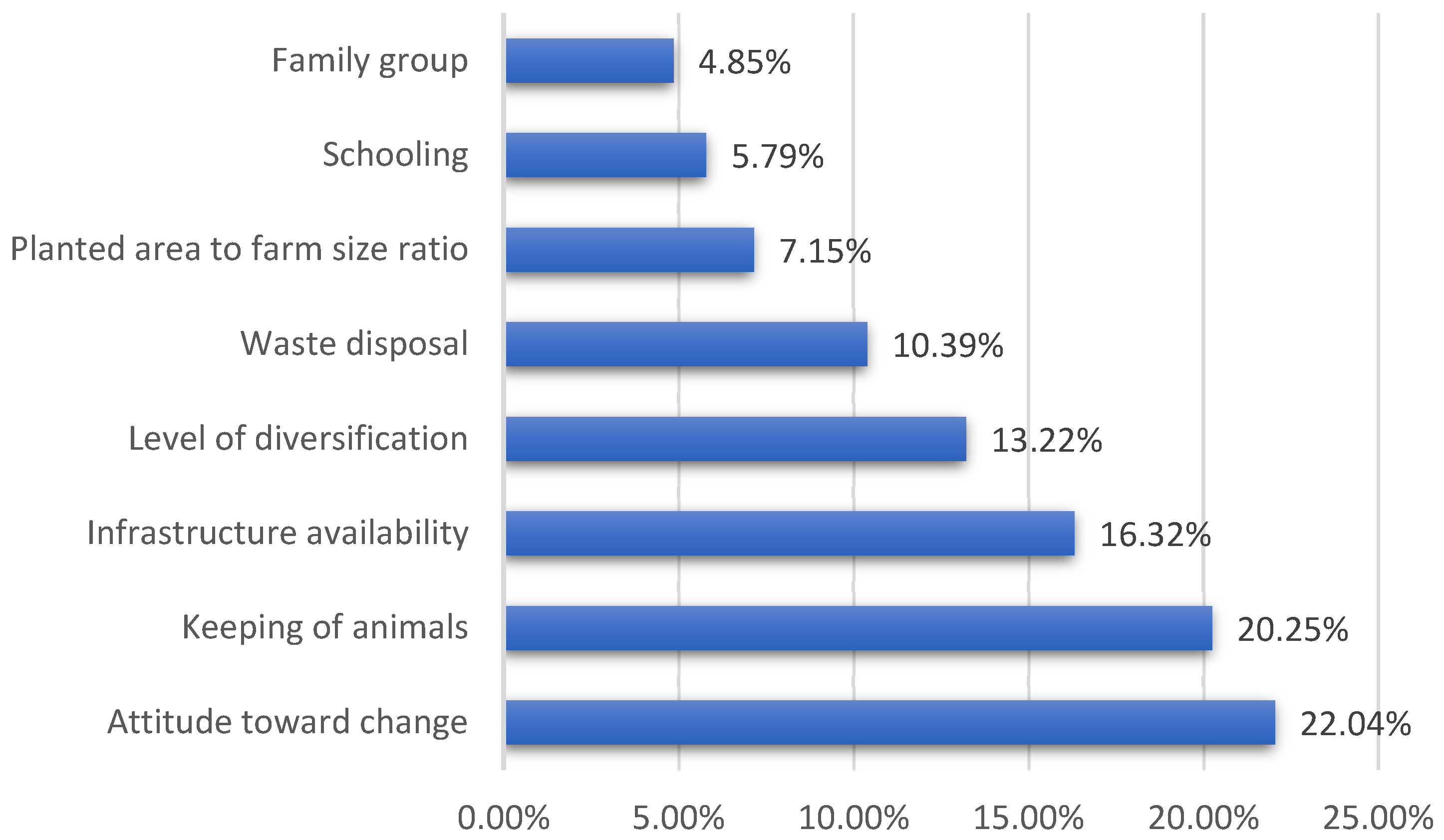
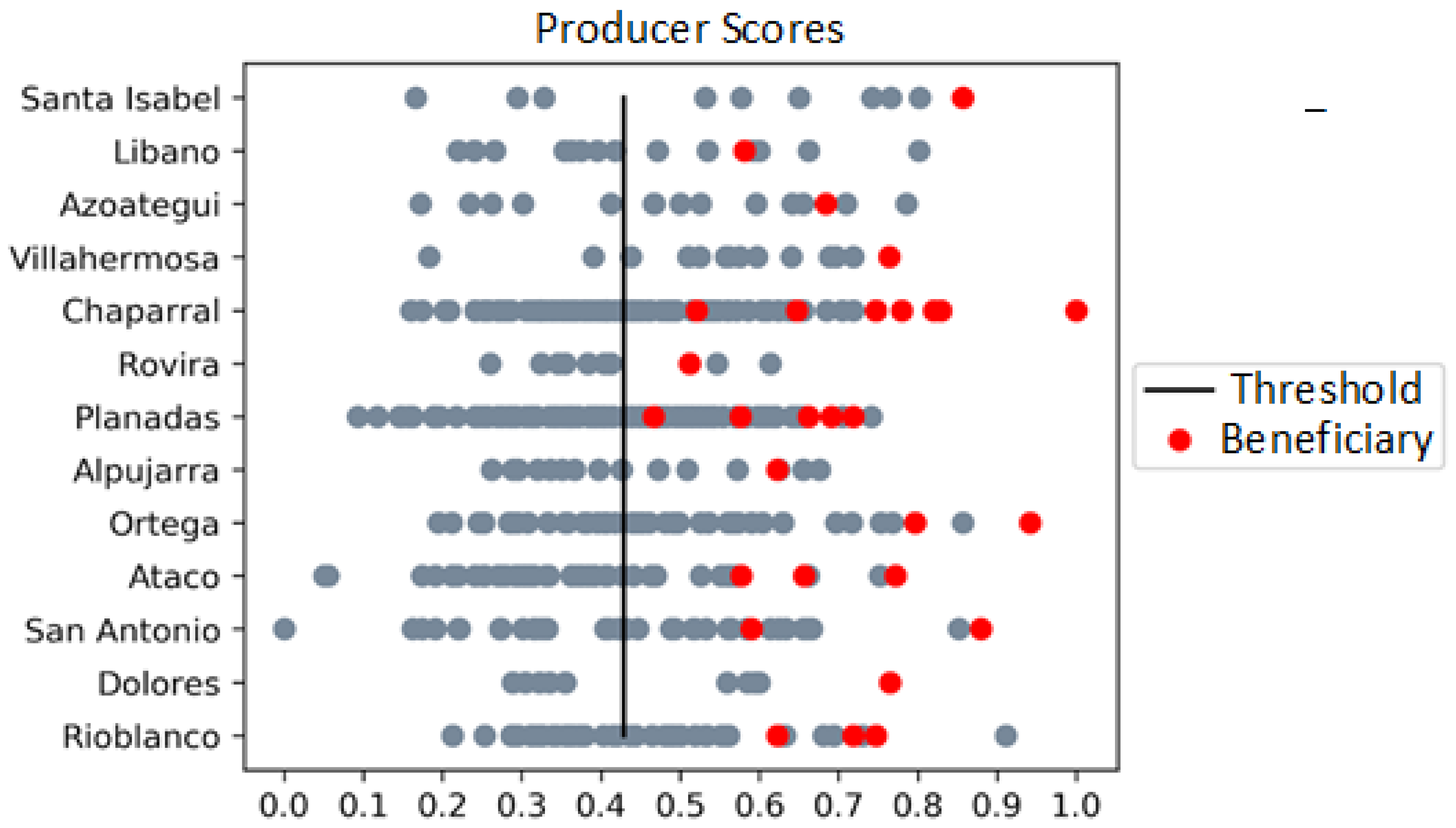
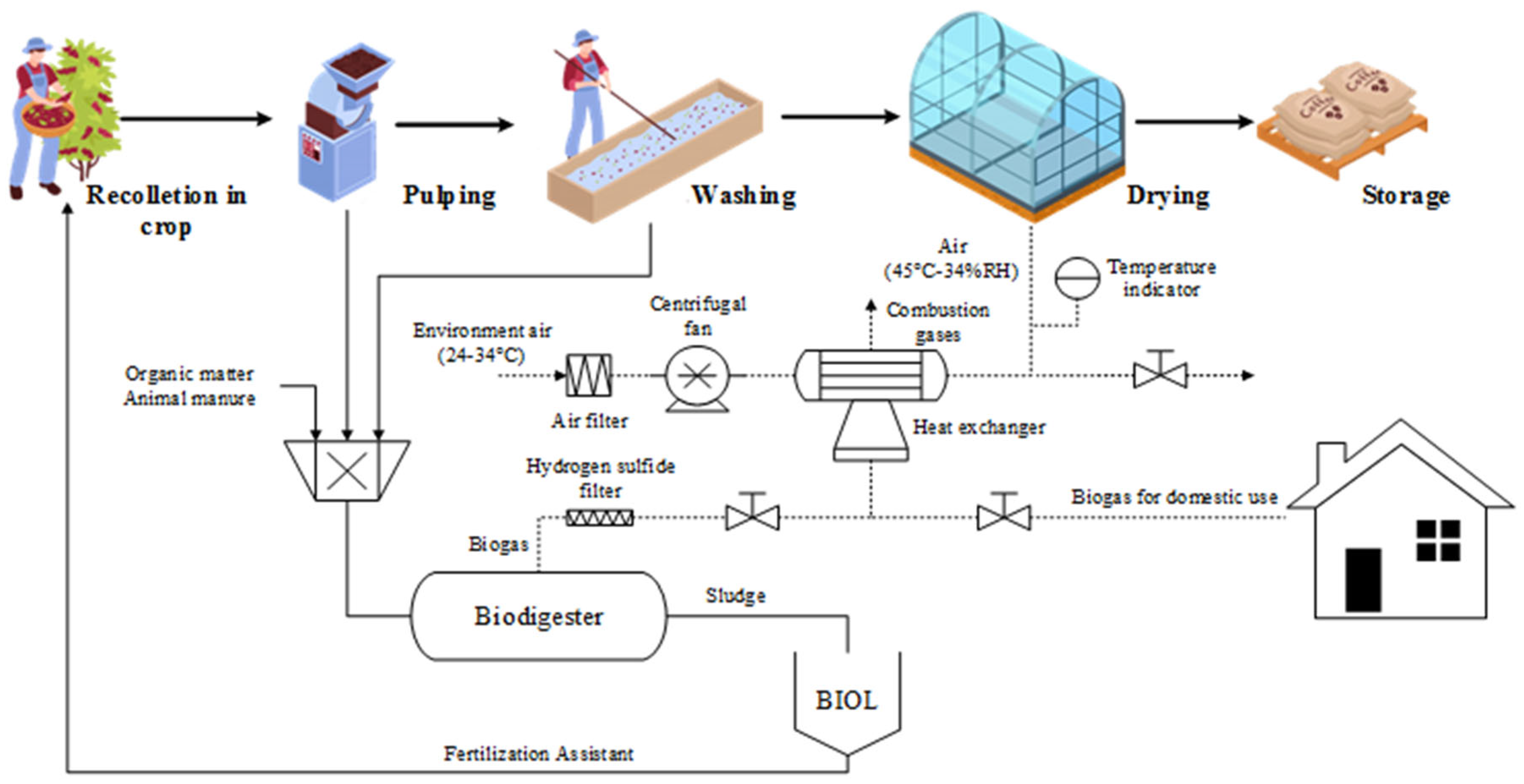
| Municipality | Farm | Altitude (masl) | CH4 (% Vol.) | CO2 (% Vol.) | H2S (ppm) | Pressure (Pa) |
|---|---|---|---|---|---|---|
| Chaparral | El Mirador | 1710 | 49.1 ± 4.6 | 43.0 ± 3.9 | 68.0 ± 6.0 | 1132.8 ± 199.9 |
| Chaparral | El Desierto | 1525 | 58.1 ± 2.4 | 27.0 ± 2.8 | 35.0 ± 1.4 | 1250.7 ± 185 |
| Planadas | El Tesoro | 1500 | 55.8 ± 2.9 | 44.2 ± 2.6 | 53.2 ± 4.3 | 1050.2 ± 201 |
Disclaimer/Publisher’s Note: The statements, opinions and data contained in all publications are solely those of the individual author(s) and contributor(s) and not of MDPI and/or the editor(s). MDPI and/or the editor(s) disclaim responsibility for any injury to people or property resulting from any ideas, methods, instructions or products referred to in the content. |
© 2023 by the authors. Licensee MDPI, Basel, Switzerland. This article is an open access article distributed under the terms and conditions of the Creative Commons Attribution (CC BY) license (https://creativecommons.org/licenses/by/4.0/).
Share and Cite
Presta-Novello, D.; Salazar-Camacho, N.A.; Delgadillo-Mirquez, L.; Hernández-Sarabia, H.M.; Álvarez-Bustos, M.d.P. Sustainable Development in the Colombian Post-Conflict—The Impact of Renewable Energies in Coffee-Growing Women. Sustainability 2023, 15, 1618. https://doi.org/10.3390/su15021618
Presta-Novello D, Salazar-Camacho NA, Delgadillo-Mirquez L, Hernández-Sarabia HM, Álvarez-Bustos MdP. Sustainable Development in the Colombian Post-Conflict—The Impact of Renewable Energies in Coffee-Growing Women. Sustainability. 2023; 15(2):1618. https://doi.org/10.3390/su15021618
Chicago/Turabian StylePresta-Novello, Déborah, Natalia Andrea Salazar-Camacho, Liliana Delgadillo-Mirquez, Héctor Mauricio Hernández-Sarabia, and Mónica del Pilar Álvarez-Bustos. 2023. "Sustainable Development in the Colombian Post-Conflict—The Impact of Renewable Energies in Coffee-Growing Women" Sustainability 15, no. 2: 1618. https://doi.org/10.3390/su15021618
APA StylePresta-Novello, D., Salazar-Camacho, N. A., Delgadillo-Mirquez, L., Hernández-Sarabia, H. M., & Álvarez-Bustos, M. d. P. (2023). Sustainable Development in the Colombian Post-Conflict—The Impact of Renewable Energies in Coffee-Growing Women. Sustainability, 15(2), 1618. https://doi.org/10.3390/su15021618







